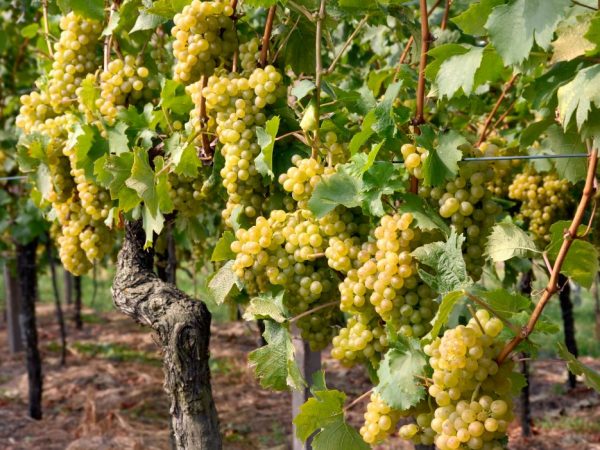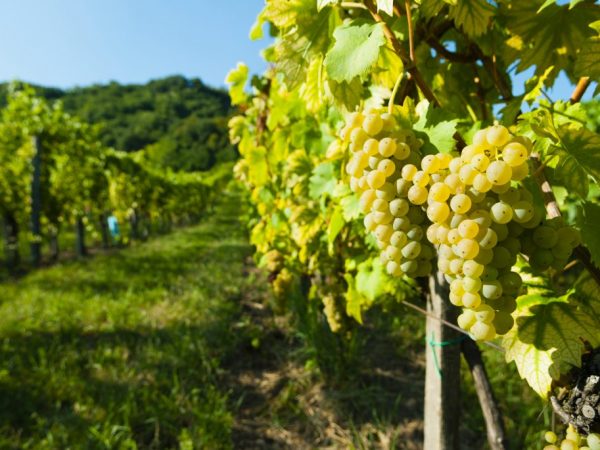Description of the Hungarian grape variety
They are engaged in the cultivation of grapes to obtain fruits that can be eaten raw, and also make them juices, wines and compotes. The plant is a perennial shrub that bears fruit every year. Hungarian grape varieties are popular among gardeners due to their unpretentiousness and taste.

Description of the Hungarian grape variety
Hungarian Kishmish
The Hungarian Kishmish grape is a hybrid cultivar obtained from the crossing of Villars and Perlet. Refers to white table varieties.
Description of Hungarian raisins:
- a large bush that requires the installation of a support;
- fast ripening period (100 days from the beginning of the growing season);
- oval-shaped berries;
- good frost resistance;
- the sugar level in fruits does not exceed 22%;
- does not contain seeds.
Grapes of the Hungarian Kishmish variety have large fruits, diameter 18 mm. They have a sweet taste without sourness. The pulp is dense and juicy, covered with a dense skin.
The bunches have a cone-like shape, in weight they reach 400-600 g. The yield of the variety is high, it also has a strong immunity to fungal diseases and harmful insects. Used to make raisins.
Hungarian nutmeg
Hungarian Muscat grapes are used for winemaking and raw consumption. The small size of the bush allows you to grow it in small areas. The yield is high. The disadvantage is the cracking of the berries from the rain. To prevent this, it is required to pick ripe fruits on time.
Other names for Hungarian nutmeg:
- Fleurd;
- Crocan;
- Orange;
- Take note.
Characteristic:
- the period of fruit ripening from the beginning of the growing season is 120 days;
- the shape of the berries is oblong, and the size is medium;
- fruit color is yellow-green;
- sweet taste with a slight sourness.
White-eye
Another name for the grapes is White Hungarian. Belongs to the group of table varieties, and is also used in winemaking.
The description of the bunches is similar to the Hungarian Kishmish. They are large in size with an average density of berries, outwardly resembling a cone. The berries are round, green or light yellow. There are dark spots and a waxy film on the surface. The yield of the variety is high. It also has good immunity against harmful insects and fungal diseases.
Binka

The Bianca variety is unpretentious in care
It is a hybrid Hungarian grape, obtained by crossing Chasselas-Bouvier and Villarbland. Due to its good frost resistance and immunity to diseases, it is grown in many regions.
Description:
- small clusters, weighing up to 130 g;
- unpretentiousness to weather conditions;
- sugar level 27%
A medium moisture soil is ideal for growing Hungarian Bianca. The bushes tolerate temperatures up to -26 ℃ normally. The taste of berries is sweet with a slight sourness. The inside is fleshy and dense flesh. Light and strong wine drinks are made from the variety.
Medovets
Other names:
- Margaretta;
- Honigler;
- Margit.
Distributed in Hungary, Croatia and Ukraine. It has dense cylindrical clusters.The juicy pulp has a sweet taste and is covered with thin skin.
It tolerates low temperatures well and is unpretentious to growing and care conditions. The yield is average. Medovets is used to make table wines. Sugar content does not exceed 20%. The disadvantage of this variety is its poor immunity to insects and fungi.
Red Kadarka
Other names:
- Red goose;
- Mekish;
- Modra;
- Grymza.
Used to make red wine. Hungarian Kadarka has a strong frost resistance and counteracts the appearance of fungal infections. The yield is high.
The bush grows quickly, which is why it requires timely pruning. Leaves in the form of 5 lobes. The bunches are large and heavy. The berries are dark red or black. A thin skin covers the juicy pulp with an unusual sweetish taste.
Blue Kekfrankosh
This variety belongs to the group of red varieties. It gives a good harvest and has a strong frost resistance. Hungarian Kekfrankos is a technical grape used to make aromatic wines and other beverages. Plum, chocolate and currant are felt in the taste.
Clusters are medium in size, growing in a cylinder shape. The berries are densely packed. The skin is firm, inside the fruit is soft and juicy pulp.
The advantage of Kekfrankosh is the low content of histamines, which does not cause allergic reactions.
Other varieties
Other popular varieties:
- Bernat Janos. It is a hybrid obtained by crossing Kadarki and Matyash.
- Pino-Naur. It is used in the production of sparkling wines and champagne.
- Cabernet Sauvignon. Used in winemaking, unpretentious to growing conditions.
- Merlot. The advantage of the variety is its high immunity.
Conclusions.
Hungarian Grapes have many benefits that make them popular for self-cultivation. Kishmish is in demand due to the lack of seeds in it.
When growing grapes, you must follow all the rules of care. For feeding, mineral and organic fertilizers are used. You should also regularly apply moisture and inspect the bushes for diseases.


